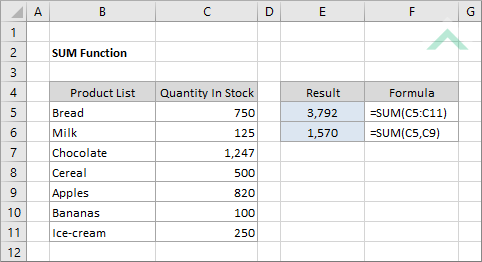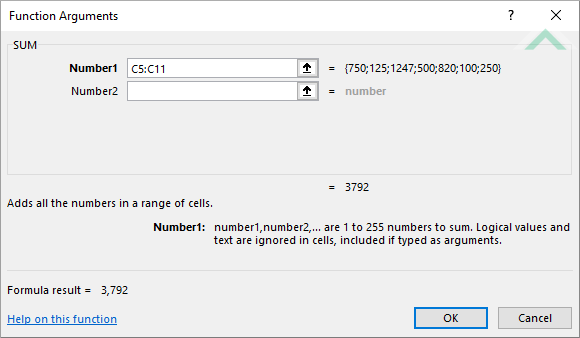Excel SUM Function
The Excel SUM function returns the sum of all numbers in a specified range
Example: Excel SUM Function

|
=SUM(C5:C11)
|
Result in cell E5 (3,792) - returns the sum of all the numbers in range (C5:C11).
|
|
=SUM(C5,C9)
|
Result in cell E6 (1,570) - returns the sum of cell C5 and C9 which are associated with Bread and Apples from the Product List.
|
METHOD 2. Excel SUM function using the Excel built-in function library
EXCEL
Formulas tab > Function Library group > Math & Trig > SUM > populate the input box
| =SUM(C5:C11) Note: in this example we are summing all of the numbers in range (C5:C11). |
 |
Sub Excel_SUM_Function()
'declare a variable
Dim ws As Worksheet
Dim ws As Worksheet
Set ws = Worksheets("SUM")
'apply the Excel SUM function
ws.Range("E5") = Application.WorksheetFunction.Sum(ws.Range("C5:C11"))
ws.Range("E6") = Application.WorksheetFunction.Sum(ws.Range("C5"), ws.Range("C9"))
ws.Range("E5") = Application.WorksheetFunction.Sum(ws.Range("C5:C11"))
ws.Range("E6") = Application.WorksheetFunction.Sum(ws.Range("C5"), ws.Range("C9"))
End Sub
OBJECTS
Worksheets: The Worksheets object represents all of the worksheets in a workbook, excluding chart sheets.
Range: The Range object is a representation of a single cell or a range of cells in a worksheet.
Worksheets: The Worksheets object represents all of the worksheets in a workbook, excluding chart sheets.
Range: The Range object is a representation of a single cell or a range of cells in a worksheet.
PREREQUISITES
Worksheet Name: Have a worksheet named SUM.
Data Range: Ensure that the data you want sum is captured in range ("C5:C11") in the SUM worksheet.
Worksheet Name: Have a worksheet named SUM.
Data Range: Ensure that the data you want sum is captured in range ("C5:C11") in the SUM worksheet.
ADJUSTABLE PARAMETERS
Output Range: Select the output range by changing the cell references ("E5") and ("E6") in the VBA code to any cell in the worksheet, that doesn't conflict with formula.
Data Range: Select the range that you want to sum by changing the range ("C5:C11") to any range in the worksheet, that doesn't conflict with the formula.
DESCRIPTION
The Excel SUM function returns the sum of all numbers in a specified range.
The Excel SUM function returns the sum of all numbers in a specified range.
SYNTAX
=SUM(number1, [number2], ...)
=SUM(number1, [number2], ...)
ARGUMENTS
number1: (Required) The first numeric value to add. This can be a single cell or a range of cells.
number2: (Optional) The second numeric value to be add. This can be a single cell or a range of cells.
number1: (Required) The first numeric value to add. This can be a single cell or a range of cells.
number2: (Optional) The second numeric value to be add. This can be a single cell or a range of cells.
ADDITIONAL NOTES
Note 1: In Excel 2007 and later the SUM function can accept up to 255 value arguments. In Excel 2003 the SUM function can only accept up to 30 value arguments.
Note 2: If you are adding a date, the formula will use the date's numeric value.
